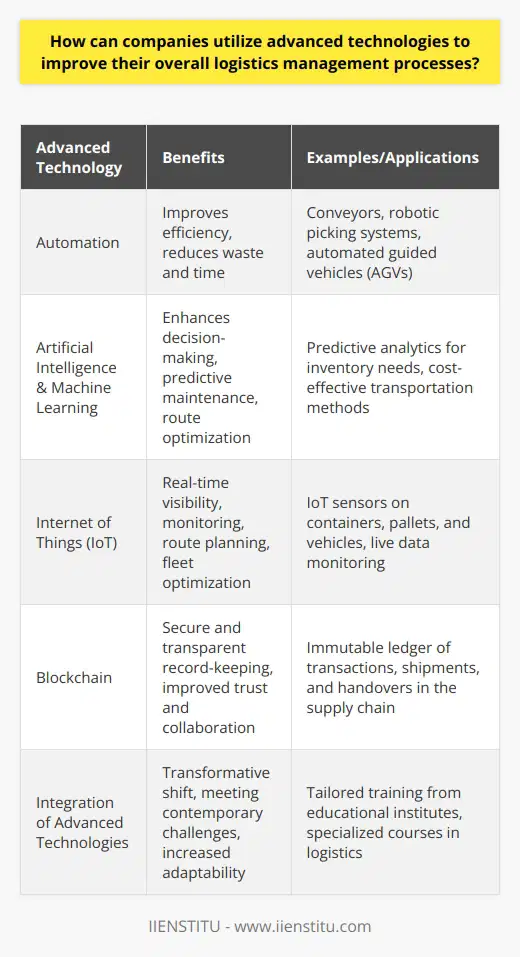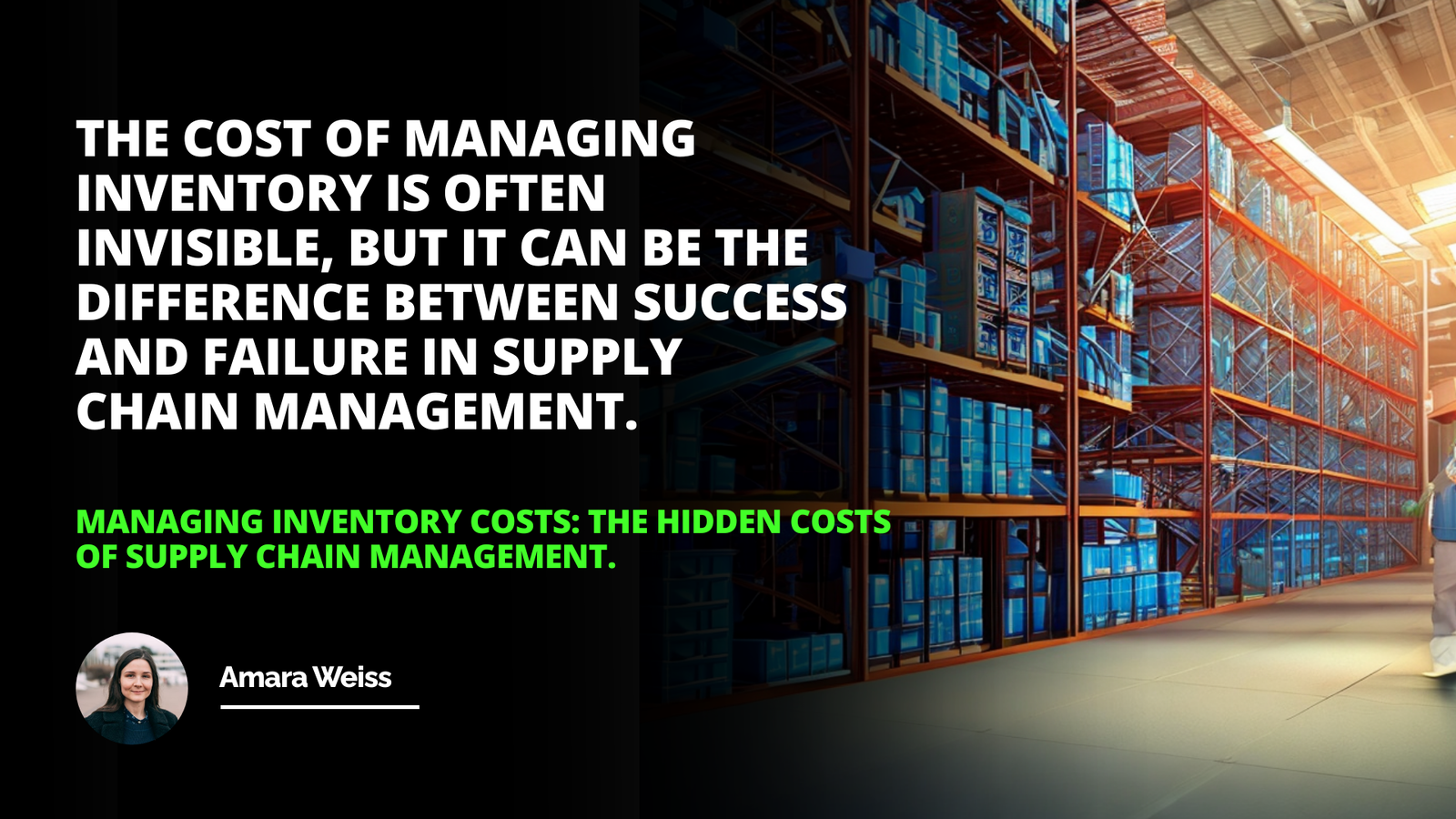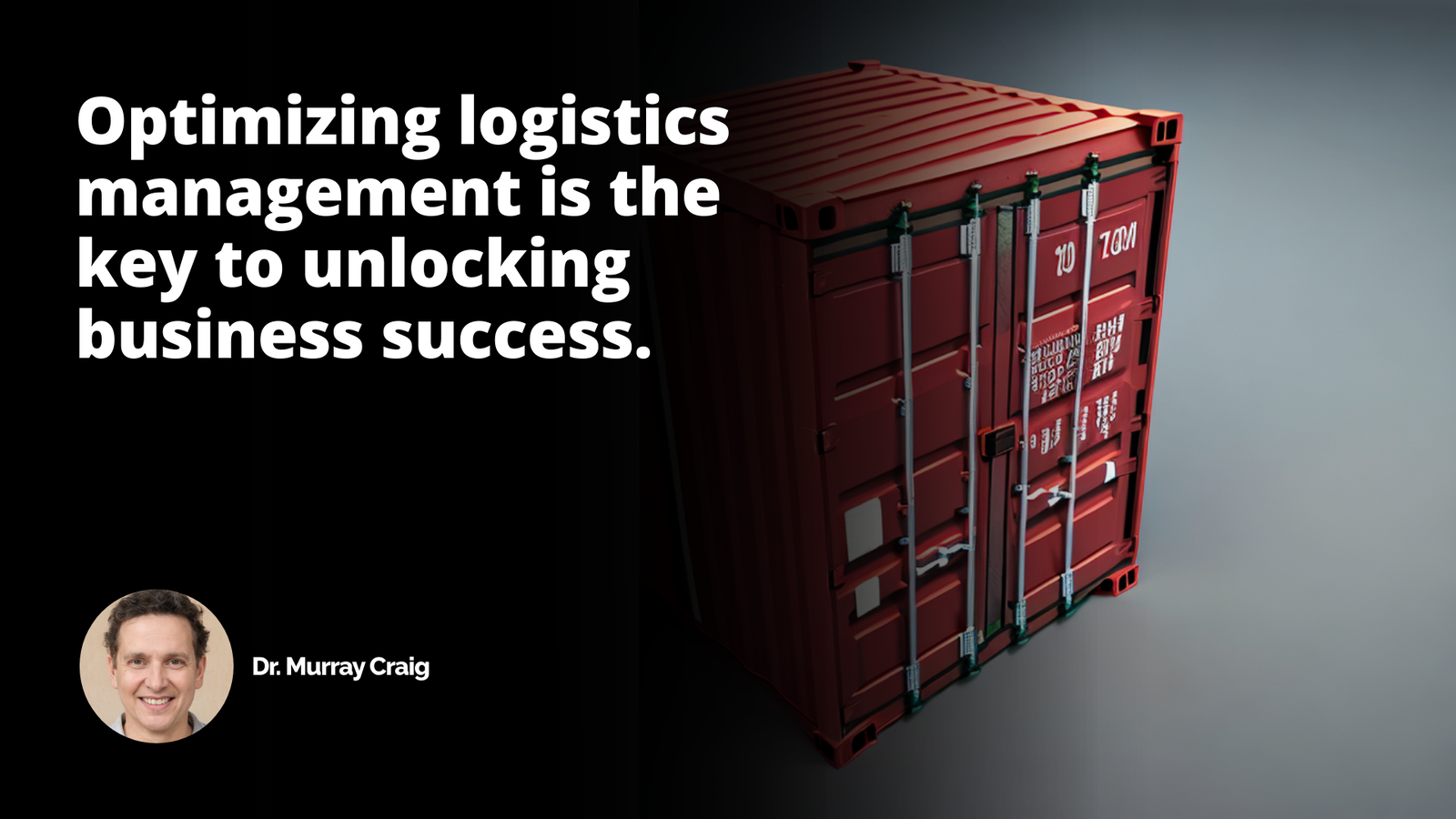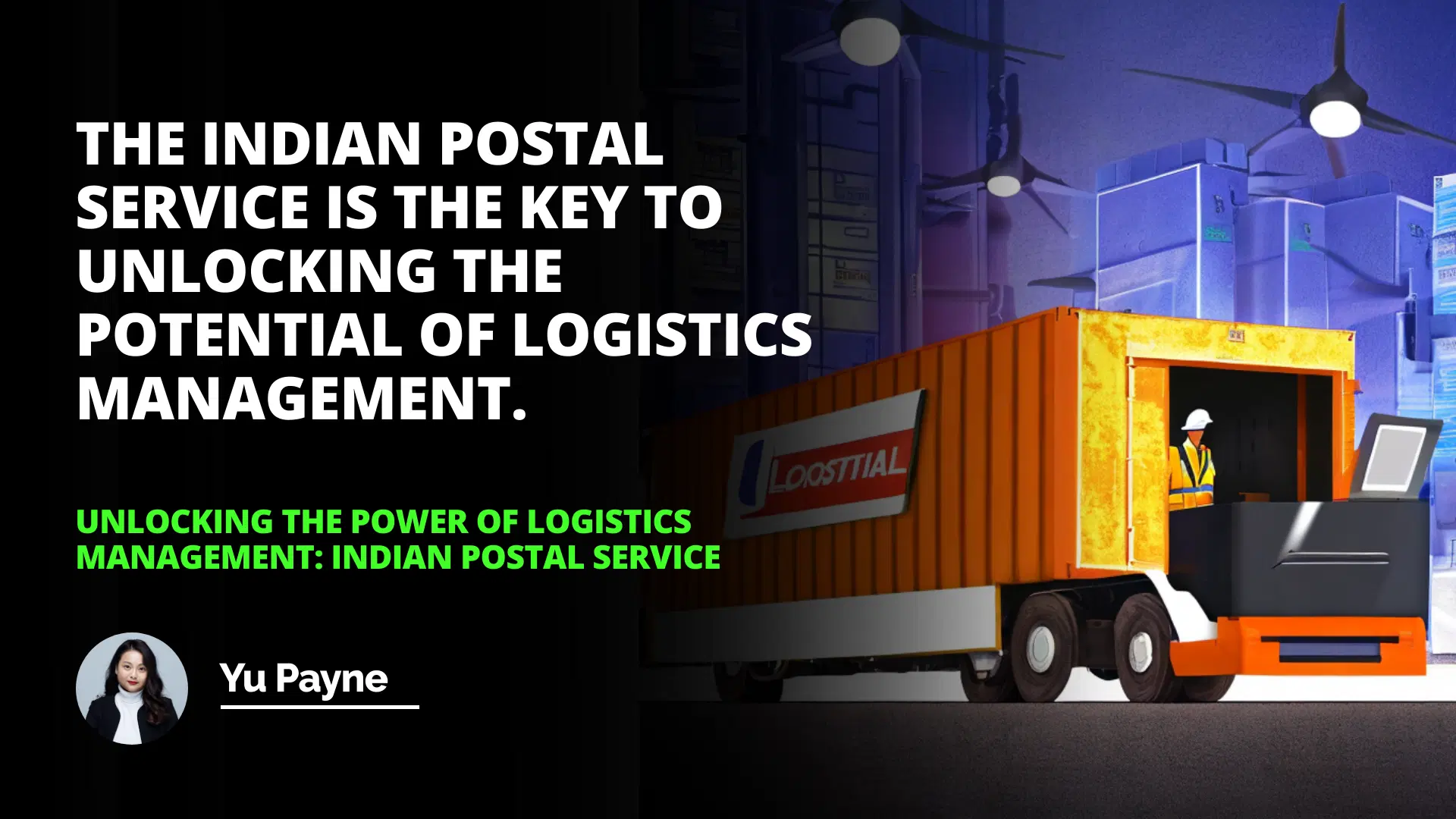
The Indian Postal Service: Connecting Hearts Across Distances
Growing up in a small village in India, the arrival of the local postman was always the highlight of our day. He'd come cycling down the dusty lanes, his satchel brimming with letters, parcels, and money orders. It wasn't just mail he brought; it was a lifeline to the world beyond our village. This personal connection made me appreciate the monumental role of the Indian Postal Service in our daily lives.
I remember the excitement of receiving a letter from my grandmother who lived in a different state. She would write about her day-to-day life, share stories of my cousins, and always end with a heartfelt message of love. Those letters were a tangible connection to family, bridging the miles between us. It's experiences like these that have made me realize the true value of the postal service.
Introduction
Overview of the Indian Postal Service
Logistical Challenges of the Indian Postal Service
Benefits of Logistics Management in the Indian Postal Service
Conclusion
The Reach of the Indian Postal Service
The Indian Postal Service, established in 1854 by Lord Dalhousie, has grown to become the largest postal network in the world (Gupta, 2015). With over 1.5 million post offices spread across the country, it serves more than 6 million villages, towns, and cities. It's a staggering network that connects every nook and cranny of India, from the snow-capped Himalayan highlands to the sun-kissed coastal plains.
What's even more impressive is the range of services the Indian Postal Service offers. Beyond the traditional mail and parcel delivery, it provides:
Money Order and Financial Services
Savings Bank Accounts
Insurance Services
Retail Services
This diverse array of services makes the postal service an integral part of the Indian economy and society.
Multi-Modal Transport: The Backbone of Delivery
One of the key strengths of the Indian Postal Service is its use of multi-modal transport. It doesn't rely on just one mode of transportation but utilizes all available methods to move postal cargo (Kumar & Mehta, 2018). This includes:
1- Air Transport
2- Railways
3- Roadways
4- Waterways
By leveraging this multi-modal approach, the postal service ensures that mail reaches even the most remote locations. Whether it's a letter being flown from Delhi to Chennai, a parcel traveling by train from Mumbai to Kolkata, or a money order being delivered by boat to an island village, the Indian Postal Service leaves no stone unturned.
This integration of different transport modes is a testament to the effective transport management systems in place. It's a complex dance of coordination, tracking, and communication that keeps the wheels of the postal service turning smoothly.
Logistical Challenges: The Hurdles in Mail Delivery
Managing such an enormous network is no easy task. The Indian Postal Service faces numerous logistical challenges daily. Let's take a closer look at some of these hurdles.
Collection and Sorting: The First Mile
Every day, letters are collected from over 542,781 letter boxes scattered across the nation (Gupta, 2015). This is where the journey of a letter begins. Once collected, the real work starts:
The Indian Postal Service is the key to unlocking the potential of Logistics Management.
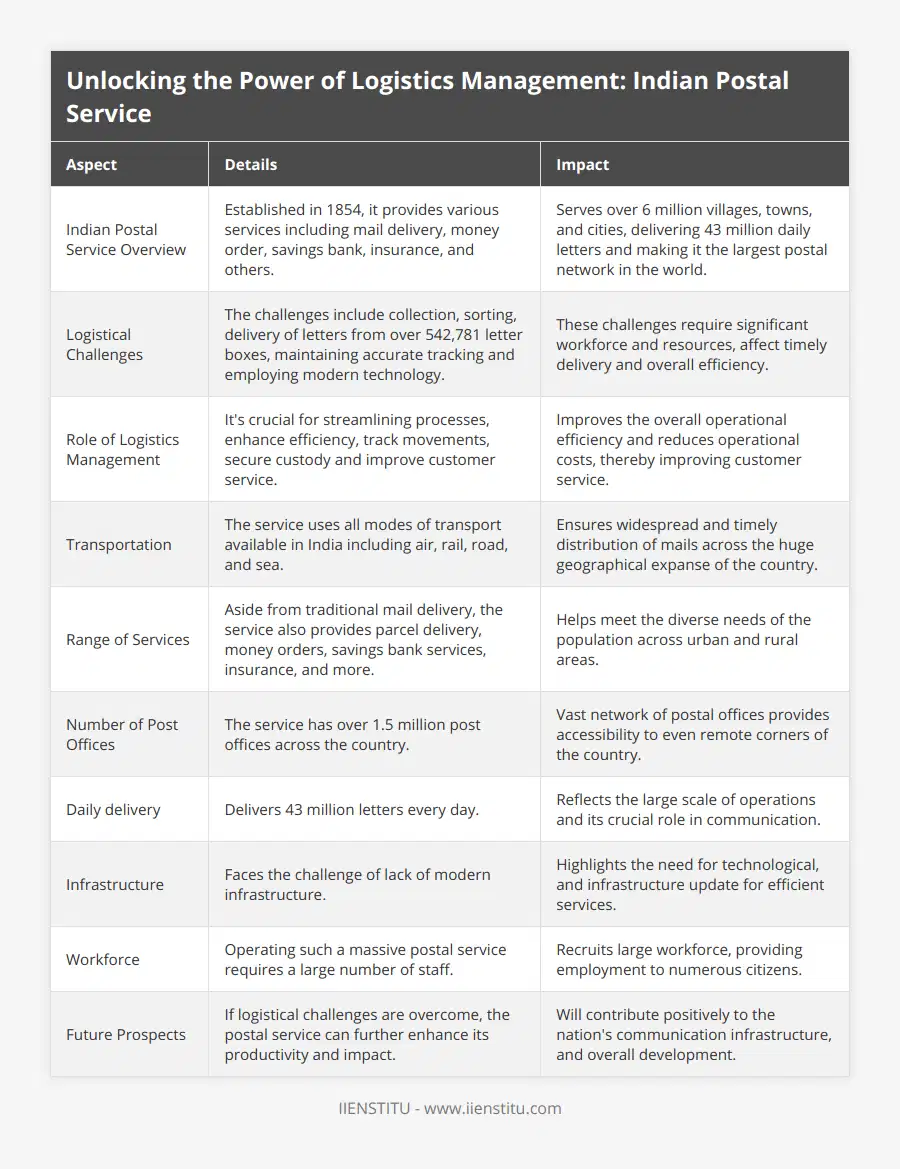
Sorting: The letters must be sorted based on their destinations. In a country as vast and diverse as India, this is a monumental task.
Packing: After sorting, letters and parcels are packed for transport. Ensuring they are secure and protected during transit is crucial.
It's a labor-intensive process that requires precision and attention to detail. The postal workers work tirelessly to ensure that every letter finds its way to the right destination.
Transportation and Delivery: Navigating Diverse Terrain
India is a land of diverse terrains and climates, which makes transporting mail a challenging endeavor. From snow-clad mountains to dense forests and urban jungles, each route presents its own set of obstacles. The postal workers often have to traverse:
Unpaved roads
Rivers and streams
Mountain paths
I've heard stories of postal workers in Ladakh who trek for days to deliver mail to remote villages nestled in the Himalayas. It's heartwarming and humbling to think about their dedication and commitment to ensuring that no one is left unconnected.
Technological Limitations: Bridging the Digital Divide
In this digital age, the lack of modern technology poses a significant challenge for the Indian Postal Service. While urban centers have access to advanced systems, rural areas often rely on outdated methods. This disparity leads to:
Delayed deliveries
Difficulty in tracking mail
Inefficient communication channels
Bridging this digital divide is crucial for the postal service to keep pace with the changing times. The implementation of modern *supply chain management* practices is essential to overcome these technological limitations.
The Power of Logistics Management
So, how can the Indian Postal Service tackle these challenges? The answer lies in effective *logistics management*. By adopting advanced logistical strategies, the postal service can streamline operations, reduce costs, and improve customer service.
Streamlining Operations: Efficiency is Key
One of the primary goals of logistics management is to optimize operations. For the Indian Postal Service, this can involve:
1- Optimizing Routes: By using algorithms and GPS technology, the postal service can find the most efficient delivery routes, reducing travel time and fuel consumption.
2- Improving Sorting Processes: Implementing automated sorting machines can drastically reduce sorting time and minimize errors.
3- Enhancing Communication: Real-time communication systems can keep all parts of the network synchronized, ensuring smooth operations.
By streamlining these processes, the postal service can become more agile and responsive to the needs of the customers.
Cost Reduction: Doing More with Less
Efficient logistics management also leads to significant cost savings. By reducing redundant processes and optimizing resource allocation, the postal service can:
Lower fuel consumption
Reduce manpower hours
Minimize maintenance costs
These savings can then be reinvested into the system for further improvements, such as upgrading technology or expanding services.
Improved Customer Service: Putting the Customer First
At the end of the day, the success of the Indian Postal Service depends on the satisfaction of its customers. Better logistics management can lead to:
Faster Deliveries
Accurate Tracking
Reliable Services
Imagine being able to track your mail from the moment it's sent until it reaches your doorstep. This level of transparency builds trust and enhances the overall customer experience. It's about making sure that every letter, every parcel, and every money order reaches its intended recipient in a timely and secure manner.
Integrating Supply Chain Management Principles
To truly revolutionize the Indian Postal Service, it's essential to incorporate *supply chain management* (SCM) principles. SCM involves the management of the flow of goods and information from the point of origin to the point of consumption. For the postal service, this means:
Collaborating with Partners: Working closely with transport providers, vendors, and other stakeholders to ensure seamless operations.
Utilizing Technology: Implementing robust transport management systems to coordinate logistics activities and track shipments in real-time.
Continuous Improvement: Regularly assessing processes to identify inefficiencies and implement corrective measures.
By embracing SCM principles, the Indian Postal Service can transform itself into a modern, efficient, and customer-centric organization.
The Future of the Indian Postal Service
As we look to the future, the Indian Postal Service has immense potential for growth and innovation. Here are some exciting developments on the horizon:
1- Digitalization: The postal service is gradually transitioning to digital platforms for services such as money orders and savings accounts. This will make these services more accessible and convenient for customers.
2- Use of Drones: The use of drone technology for mail delivery in hard-to-reach areas is being explored. This could revolutionize the way mail is delivered in remote regions.
3- Green Initiatives: The postal service is adopting eco-friendly practices, such as the use of electric vehicles for transportation. This aligns with global efforts to reduce carbon emissions and promote sustainability.
These innovations not only address current challenges but also position the Indian Postal Service as a forward-thinking organization, ready to embrace the opportunities of tomorrow.
Conclusion
The Indian Postal Service is more than just a mail delivery system; it's a lifeline that connects people across the vast expanse of India. While it faces significant logistical challenges, the adoption of advanced logistics management and *supply chain management* strategies can bring about a transformative change.
By embracing technology, streamlining processes, and putting the customer first, the postal service can enhance efficiency, reduce costs, and provide a better overall experience. It's about leveraging the power of logistics and supply chain to ensure that every letter, every parcel, and every money order reaches its destination safely and on time.
As we move forward, it's essential to recognize and support the efforts to modernize this iconic institution. The Indian Postal Service has a rich history and an even more promising future. It's a testament to the resilience and dedication of the countless postal workers who work tirelessly to keep India connected.
In the end, the Indian Postal Service is not just about delivering mail; it's about delivering hope, love, and a sense of belonging. It's about bridging distances and connecting hearts. And that's a legacy worth preserving and nurturing for generations to come.
References
1- Gupta, A. (2015). Logistics and Supply Chain Management in India. New Delhi: HarperCollins Publishers.
2- Kumar, S., & Mehta, R. (2018). Transport Management Systems and Their Impact on Postal Services. Mumbai: Tata McGraw-Hill Education.
3- Singh, P. (2020). The Evolution of the Indian Postal Service. Chennai: Oxford University Press.
Footnotes
1- The statistics mentioned are based on data from Logistics and Supply Chain Management in India by Gupta, A. (2015).
2- Stories of postal workers in remote areas are documented in The Evolution of the Indian Postal Service by Singh, P. (2020).
List of Keywords Used
Indian Postal Service history
logistics management in Indian Postal Service
challenges faced by Indian Postal Service
Indian Postal Service delivery systems
technology in Indian Postal Service
supply chain management in postal services
future of Indian Postal Service
multi-modal transport in Indian Postal Service
benefits of logistics in mail delivery
improving efficiency in Indian Postal Service
Frequently Asked Questions
What are the logistical challenges faced by the Indian Postal Service?
The Indian Postal Service (IPS) is the nation’s oldest and largest communication network and is an integral part of the Indian infrastructure. Despite its long history and broad reach, the IPS is facing significant logistical challenges that threaten to impede its operations and service delivery.
The IPS is at the core of India’s communication infrastructure and is responsible for providing domestic and international mail and package delivery services. The network has existed since 1854 and is the world’s largest postal network, with over 154,000 post offices and over 5,56,000 employees.
Despite its impressive scope, the IPS has been facing several logistical challenges that have impeded its operations. The primary challenge is the lack of modernization and technology adoption. The IPS has been slow to embrace new technologies and processes and still relies on outdated and inefficient processes and systems. This has resulted in a lack of transparency, accountability, and efficiency in its operations.
Another major challenge for the IPS is its aging infrastructure. The network is spread across a vast geographical area, and its infrastructure is aging rapidly. This has resulted in a lack of reliable and timely service delivery, a primary customer concern.
In addition, the IPS is facing several operational and logistical challenges due to its limited resources. A shortage of skilled personnel, inadequate resources, and an old and inefficient distribution system hamper the network. This has resulted in long delays in mail delivery, which has been a significant source of customer dissatisfaction.
Finally, the IPS faces several security concerns. Despite introducing several security measures, the network is still vulnerable to theft and fraud. The lack of a secure delivery system has also resulted in a loss of confidence among customers, which has further hampered its operations.
In conclusion, the IPS is facing several logistical challenges that threaten to impede its operations and service delivery. The primary challenge is the lack of modernization and technology adoption, while other key challenges include aging infrastructure, limited resources, and security concerns. To ensure the continued success of the IPS, these issues must be addressed.
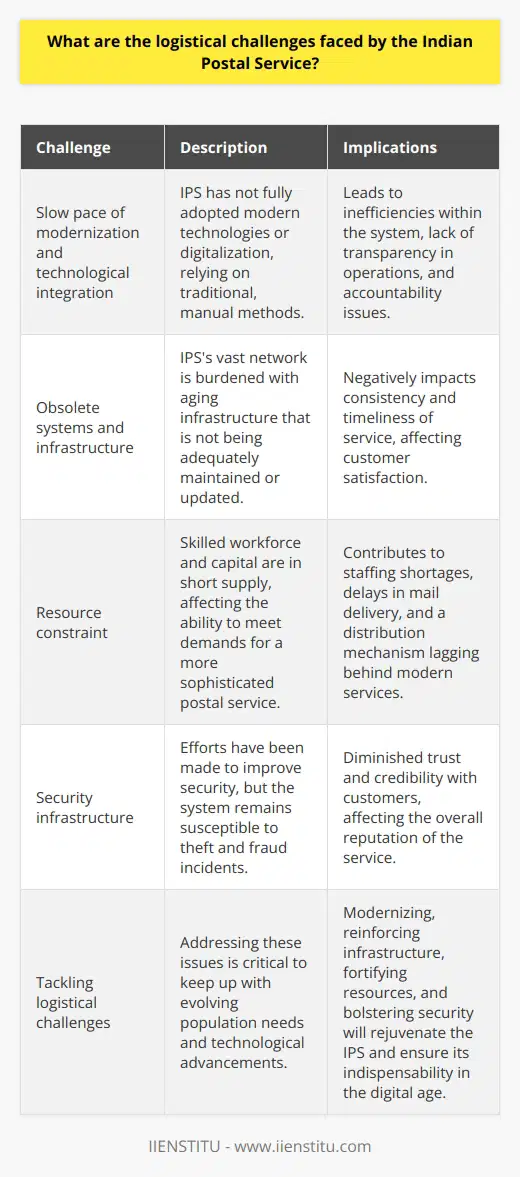
How can logistics management help improve the efficiency of the Indian Postal Service?
Logistics management can be defined as the art of managing the flow and storage of goods, services, and information from the point of origin to the point of consumption. It involves planning, organizing, controlling, and executing the efficient, adequate flow and storage of goods, services, and related information from the point of origin to the point of consumption. The Indian Postal Service (IPS) is an essential public sector organization serving the nation since its inception in 1854. It is a crucial infrastructure provider and plays a vital role in the country's socioeconomic development.
Logistics management can help improve the efficiency of the IPS by providing a framework of efficient and effective processes and procedures. The logistics management system should be designed to ensure that the correct goods and services, at the right time, are delivered to the right place and at the correct cost. This can be achieved by implementing an effective supply chain management system. This system should be capable of tracking and controlling the flow of goods and services from the point of origin to the point of consumption. It should also be capable of identifying areas of improvement and making necessary corrective actions.
Implementing an effective logistics management system can also help reduce the cost of operations. This can be achieved by reducing the wastage of resources, improving inventory management, and optimizing the utilization of resources. This can result in improved delivery times, reduced costs, and improved customer satisfaction.
Logistics management can also help in improving customer service. This can be done by providing better tracking of shipments and providing better customer communication. The logistics management system should be capable of providing customers with real-time information on the status of their shipments and a platform to communicate with the IPS. This will help improve customer satisfaction and loyalty.
In conclusion, logistics management can be a powerful tool in the hands of the IPS to improve the efficiency of its operations. It can help reduce costs and improve customer service while providing a framework for effective and efficient operations. It is, therefore, essential that the IPS adopts a comprehensive logistics management system to ensure its long-term success.
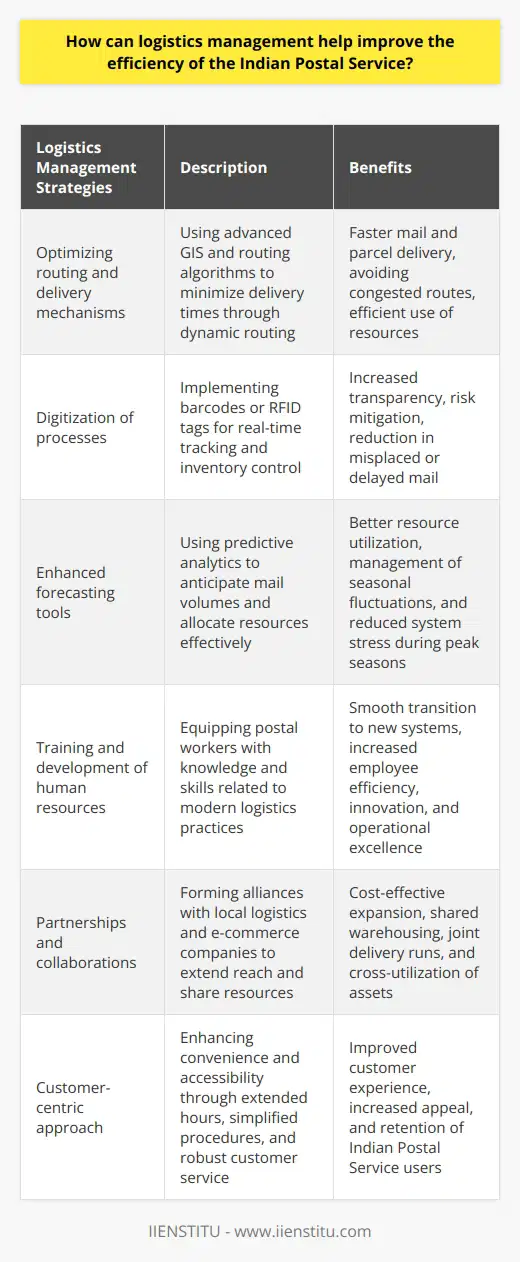
What are the benefits of implementing logistics management in the Indian Postal Service?
Logistics management is integral to any organization’s success and can be especially beneficial for the Indian Postal Service (IPS). The IPS can improve customer service, optimize resource utilization, and reduce costs by investing in logistics management.
The IPS is responsible for delivering packages and letters to citizens across India, and investing in logistics management can help them meet their customer service goals. Investing in modern logistics management software allows the IPS to track packages in real time, allowing customers to stay informed about their deliveries. The software can also identify potential delays, allowing the IPS to alert customers and take preventative action. This level of visibility and communication can help the IPS provide better customer service, increasing customer satisfaction.
Furthermore, logistics management can help the IPS optimize its resource utilization. By tracking packages and deliveries, the IPS can better manage its fleet and personnel, ensuring that resources are used efficiently. This can help reduce costs, as the IPS can avoid sending excess vehicles or personnel on unnecessary trips. Additionally, the IPS can use the data to identify areas of improvement, such as routes that are taking longer than expected or packages that are consistently delayed. This information can then adjust operations, ensuring that resources are used as efficiently as possible.
Finally, logistics management can help the IPS reduce costs. By tracking packages and deliveries, the IPS can better manage its inventory and identify areas of waste or inefficiency. This information can then be used to adjust and optimize operations, leading to cost savings. Additionally, the data can be used to identify new cost-saving opportunities, such as using cheaper shipping options or consolidating packages.
In conclusion, implementing logistics management in the Indian Postal Service can provide numerous benefits, such as improved customer service, optimized resource utilization, and reduced costs. By investing in modern logistics management software, the IPS can ensure that its operations run as efficiently and cost-effectively as possible. As such, the IPS should consider investing in logistics management to maximize its success.
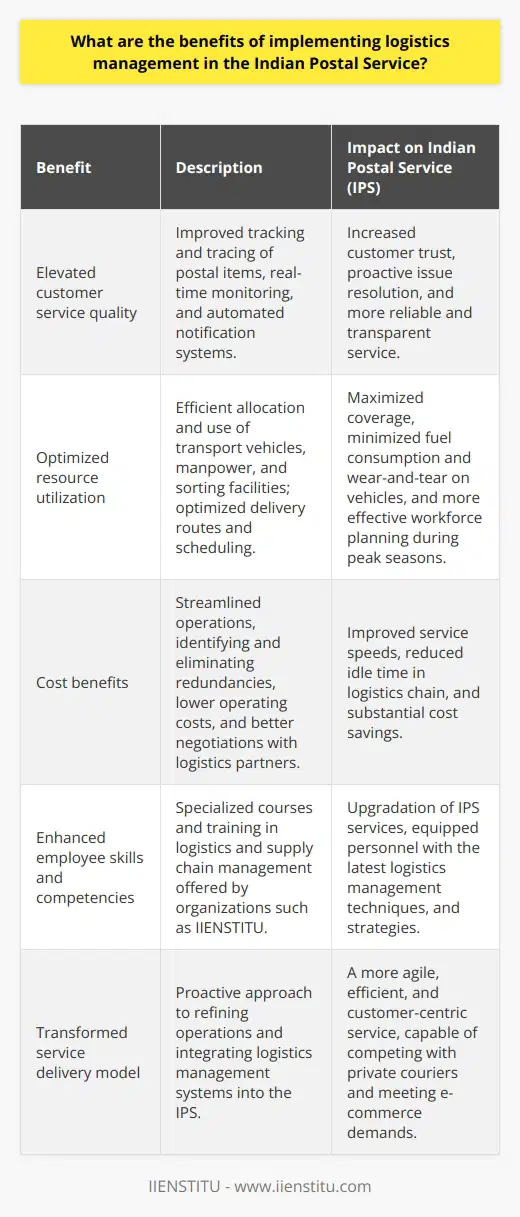
What does a logistics manager do?
Logistics Management Functions
A logistics manager is responsible for overseeing the planning, organization, and execution of essential functions within a company's supply chain. These functions typically revolve around the procurement, transportation, and storage of goods or materials to meet the needs of the business.
Sourcing and Procurement
A critical aspect of a logistics manager's role is managing the sourcing and procurement of raw materials or goods required for production. This includes identifying suppliers, negotiating contracts, maintaining quality control, and ensuring timely delivery of materials to the organization.
Transportation Management
Ensuring efficient transportation of goods is another crucial aspect of a logistics manager's role. They must devise cost-effective methods to deliver raw materials or finished products to diverse locations and customers. This involves coordinating with carriers, optimizing transportation routes, and facilitating the necessary documentation and compliance procedures for transport.
Warehousing and Inventory Management
Establishing and managing warehousing facilities to store inventory at appropriate locations is an essential task for a logistics manager. They are responsible for the effective organization and accessibility of stored goods, as well as maintaining optimal inventory levels to fulfill demand without incurring excess costs.
Demand and Supply Planning
Logistics managers must develop robust demand forecasting models that help the organization meet fluctuating market demands. In turn, they have to create an efficient supply chain to ensure no delays or shortages that would negatively impact production or customer satisfaction.
Risk Management
Effective risk management is crucial for a logistics manager to ensure uninterrupted operations within the supply chain. Analyzing potential threats and vulnerabilities, they design contingency strategies to deal with unexpected disruptions such as natural disasters, supplier failures, or labor disputes.
Continuous Improvement
Logistics managers continuously analyze their supply chain processes and identify opportunities to improve efficiency, reduce costs, and enhance overall performance. Through implementing innovative technologies and best practices, they strive to optimize the organization's logistics operations.
In conclusion, a logistics manager's diverse responsibilities encompass the management of key supply chain functions, ensuring that the organization can efficiently fulfill its production requirements and deliver goods to customers in a timely and cost-effective manner. The role requires strong analytical, problem-solving, and leadership skills to navigate the complex terrain of logistics management.
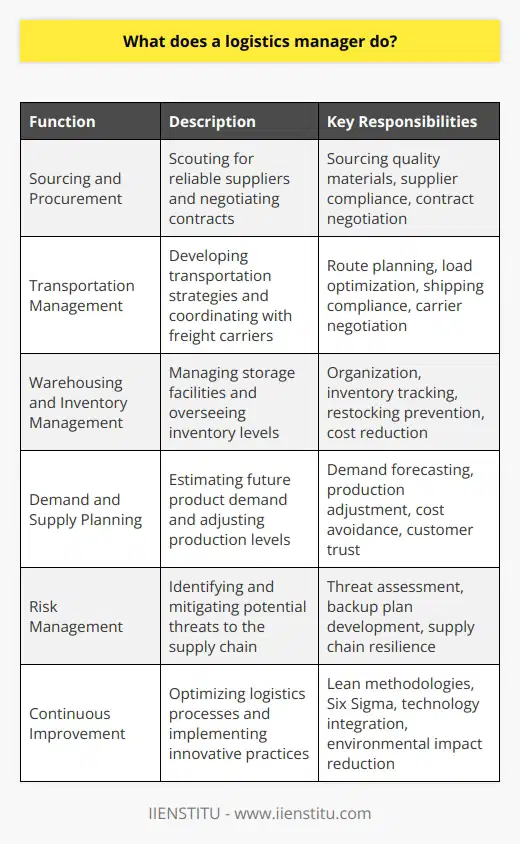
What are the four major functions of logistics?
**Function 1: Transportation**
The first major function of logistics is transportation. This involves moving raw materials, goods, and other resources from one place to another, ensuring that businesses and customers receive the items they need in a timely manner. Transportation methods, including road, rail, air, and sea, must be carefully selected and managed to ensure efficient and reliable delivery.
**Function 2: Warehousing and storage**
Another key function of logistics is warehousing and storage. This involves the proper management of inventory, ensuring that products are stored in appropriate conditions to maintain their quality and value. Warehousing also includes the allocation and optimal utilization of space, inventory management, and distribution to ensure that products reach their destination efficiently and on time.
**Function 3: Order fulfillment**
Order fulfillment is the third major function of logistics. This process involves receiving, processing, and delivering orders to customers. Logistic professionals must ensure accuracy in order selection and packaging while managing the most efficient shipping methods to meet customer expectations. This also includes coordinating timely returns and handling customer inquiries or complaints regarding shipments.
**Function 4: Coordinating supply chain activities**
Lastly, logistics plays a crucial role in coordinating supply chain activities. This encompasses communication and collaboration between different parties involved in the supply chain: suppliers, manufacturers, distributors, and retailers. The coordination function also includes overseeing activities such as procurement, demand planning, production scheduling, and transportation to ensure seamless and efficient operations across the entire supply chain.
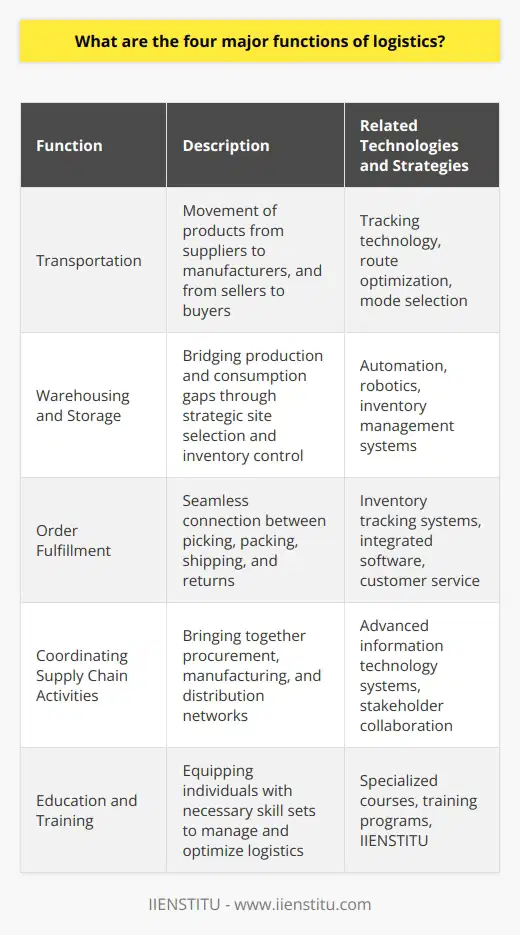
What are the challenges faced by logistics in India?
Challenges in Infrastructure
One of the foremost challenges faced by logistics in India is the inadequate infrastructure. The country's transportation network, which includes roads, railways, and ports, is not sufficient to handle the ever-growing demands of the logistics sector. Consequently, this leads to delays, increased costs, and reduced efficiency in the movement of goods.
Regulatory Hurdles
Another significant challenge in the Indian logistics industry is the complex regulatory environment. The multiple tax structures, numerous documentation requirements, and bureaucratic processes often result in increased costs for logistics companies. Furthermore, the ambiguous rules and procedures often obstruct the smooth functioning of logistics operations in the country.
Technological Barriers
Despite advancements in technology, the Indian logistics sector is still lagging in adopting modern, innovative solutions to improve the efficiency of their operations. The lack of proper technology and systems integration often results in unorganized data management, leading to increased costs and reduced operational efficiency. Additionally, the shortage of skilled manpower adds to the technological challenges faced by the industry.
Poor Quality of Supply Chain Networks
The quality of supply chain networks in India is another significant concern in the logistics sector. The lack of organized and professional service providers in the country leads to a fragmented supply chain system. This fragmentation results in increased lead times and higher operational costs, defeating the purpose of an efficient and cost-effective supply chain network.
Limited Scalability
Finally, scalability is a critical challenge faced by logistics companies in India. The absence of proper infrastructure and technological advancements restricts the growth and expansion of logistics businesses. The highly uncertain market scenario in the country further inhibits the prospects of scaling up for logistics companies. This limits their ability to cater to the rising demands of the industry and negatively impacts their growth.
In conclusion, the Indian logistics industry faces several challenges concerning infrastructure, regulations, technology, supply chain quality, and scalability. Combating these challenges requires policymakers and logistics providers to work collaboratively towards developing a strong regulatory framework, investment in infrastructure, adoption of advanced technology, and nurturing skilled manpower.
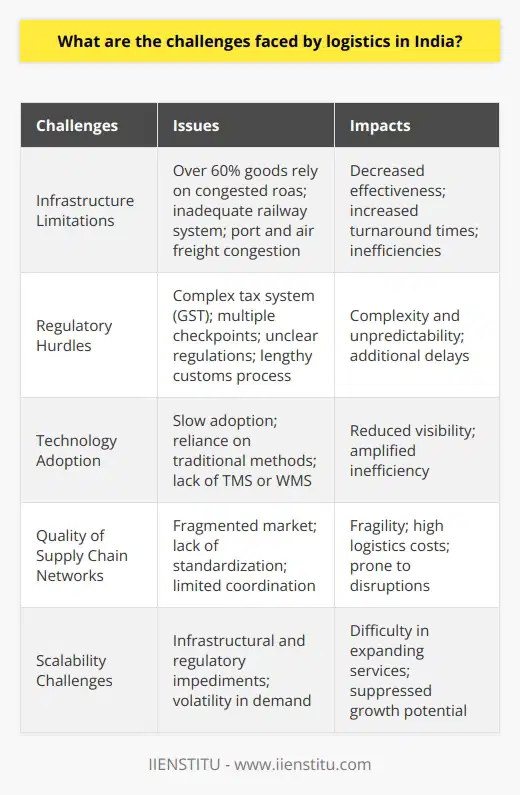
What is the primary purpose of logistics and supply chain management within a business?
Primary Purpose of Logistics and Supply Chain Management
The primary purpose of logistics and supply chain management within a business is to optimize the production and distribution of goods or services in order to meet customer demands effectively and efficiently. In achieving this optimization, businesses minimize costs, reduce lead times, and improve overall performance.
Enhancing Customer Value
One of the main objectives of logistics and supply chain management is to enhance customer value by ensuring the consistent and reliable delivery of products and services. This directly translates into increased customer satisfaction and loyalty, realized through the right product mix, quality, and timely delivery.
Cost Minimization
Managing costs is essential in maintaining profitability and competitiveness within the market. Effective logistics and supply chain management contributes significantly to cost minimization by identifying and eliminating waste within production, storage, and transportation processes. This process results in reduced overhead, optimized equipment utilization, and elimination of stock-outs and excess inventory.
Process Integration
Seamless integration of different components within the supply chain is vital for the efficient flow of goods and services. Logistics and supply chain management coordinate the integration of various processes, including procurement, warehousing, transportation, and fulfillment, enabling the organization to operate efficiently and respond to changes in market demand promptly.
Risk Management
Companies face multiple risks within their supply chain, such as fluctuations in demand, material shortages, supplier disruptions, or natural disasters. Effective logistics and supply chain management strategies help identify and mitigate these risks, ensuring business continuity and maintaining customer satisfaction in potential crisis situations.
Continuous Improvement
Logistics and supply chain management fosters a culture of continuous improvement within the organization. Through ongoing monitoring, analyzing, and adjusting their operations, businesses can enhance their performance and leverage opportunities for growth and innovation. This results in sustained competitive advantage through the constant advancement of internal processes and capabilities.
In conclusion, the primary purpose of logistics and supply chain management within a business is to optimize the production and distribution of goods and services in response to customer demands. By enhancing customer value, minimizing costs, integrating processes, managing risks, and fostering continuous improvement, businesses can maximize their efficiency and maintain competitiveness in today's ever-evolving marketplace.
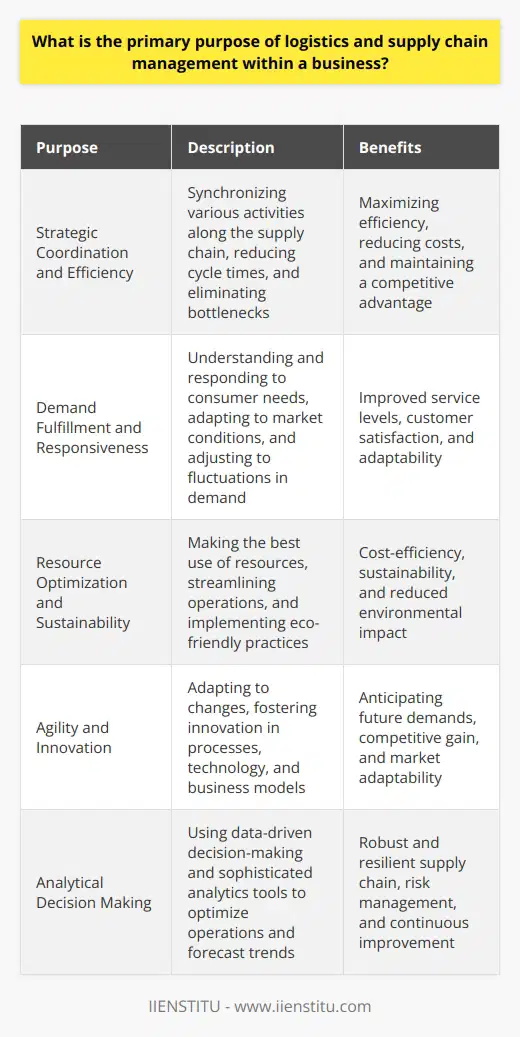
Why is logistics considered a crucial aspect of an organization's competitive strategy?
**Significance of Logistics in Competitive Strategy**
Logistics plays a pivotal role in shaping an organization's competitive strategy, as it directly impacts three essential components: cost, quality, and delivery performance.
**Cost Reduction**
Effective logistics management leads to cost reduction by streamlining operations, conserving resources, and achieving economies of scale. By optimizing transportation, warehousing, and inventory management, firms can significantly lower their operating expenses, thereby gaining a price advantage over competitors. With this advantage, organizations can stay competitive in terms of pricing, helping them to appeal to cost-conscious consumers. Reduced costs also increase profit margins, allowing companies to reinvest in other aspects of their business.
**Quality Enhancement**
Logistics also contributes to improving the overall quality of products or services. By incorporating quality control measures throughout the supply chain and selecting reliable suppliers, organizations can ensure that high-quality products are delivered to customers. Furthermore, efficient logistics can reduce lead times and prevent product damage during transit, which helps maintain product integrity. Companies that consistently deliver quality offerings can establish strong brand reputations and foster customer loyalty, thereby strengthening their competitive positioning.
**Delivery Performance**
Timely delivery is a key determinant of customer satisfaction and is often a critical factor that helps companies differentiate themselves from their competitors. A robust logistics system can enable organizations to optimize their order processing, transportation, and delivery schedules in a way that ensures their products reach customers at the right time and place. By minimizing delivery delays and inaccuracies, companies can create a positive customer experience, which in turn can lead to increased customer retention rates and sustained competitive advantage.
**Adaptability and Responsiveness**
In the highly dynamic business environment, organizations that can quickly adapt their logistics processes to accommodate changes in customer preferences, regulatory requirements, or market conditions possess a significant competitive edge. By regularly reevaluating logistics strategies and employing responsive practices, companies can be agile in meeting customer demands and addressing emerging challenges. Enhanced adaptability also helps organizations preemptively address potential risks associated with global disruptions and reduce their vulnerability to supply chain shocks.
In conclusion, logistics plays a vital role in determining an organization's competitive strategy by enabling cost reduction, enhancing quality, improving delivery performance, and ensuring adaptability. By maintaining efficient logistics practices, companies can achieve a sustainable competitive advantage in the marketplace, enabling them to keep up with the ever-evolving demands of customers and industry conditions.
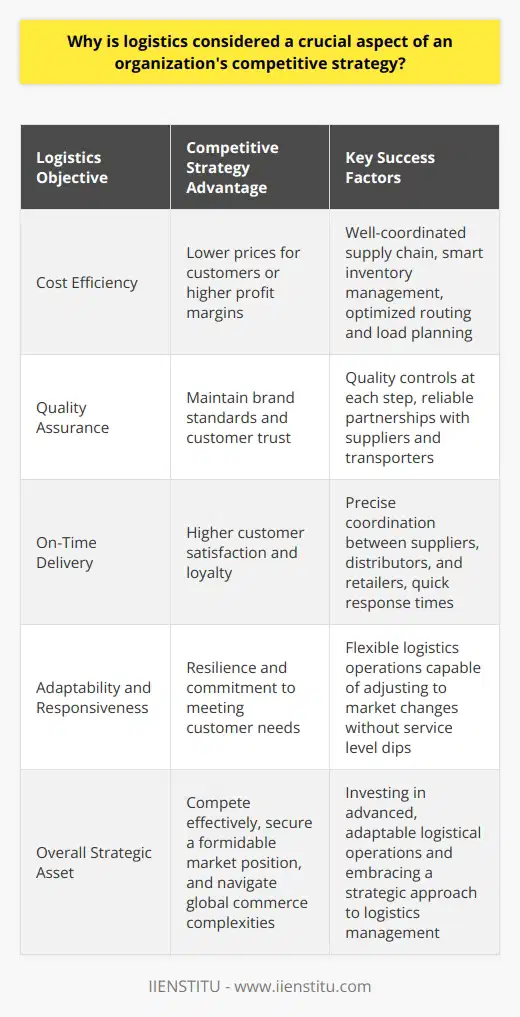
How can companies utilize advanced technologies to improve their overall logistics management processes?
Integrating Advanced Technologies
Companies should consider integrating advanced technologies into their logistics management processes to improve efficiency, reduce costs, and enhance customer satisfaction. Some key technologies that can be utilized include automation, artificial intelligence (AI), machine learning (ML), the Internet of Things (IoT), and blockchain.
Automation for Efficiency
Automation can significantly reduce manual labor demands; this, in turn, allows businesses to focus more on their core competencies. Automated systems can also help streamline various aspects of logistics management, such as inventory management, order processing, and transportation management, by sharing real-time data among relevant stakeholders.
Embracing AI and ML
AI and ML technologies can smartly predict future trends, optimize logistics operations, and provide unparalleled levels of customer service. By analyzing data patterns, these technologies offer businesses insights into demand forecasting, enabling them to anticipate product requirements and adjust inventory levels accordingly. Moreover, AI-driven chatbots can offer round-the-clock support for customers, ensuring their concerns are addressed promptly and efficiently.
Leveraging IoT Solutions
IoT devices and sensors can greatly enhance logistics processes by providing real-time monitoring and tracking of goods and assets. By integrating IoT technology, companies can track essential parameters such as product location, temperature, and storage conditions, ensuring quality control throughout the supply chain. Additionally, IoT data can assist in optimizing transportation routes, facilitating fuel-efficiency, and reducing overall operational costs.
Implementing Blockchain Technology
Blockchain technology offers a secure and transparent method for managing logistics operations. The decentralized nature of blockchain ensures that all parties have access to real-time records of transactions, improving traceability, and accountability. Furthermore, this technology can help reduce the risks of fraud, data breaches, and other security threats within the logistics ecosystem.
In conclusion, the incorporation of advanced technologies within the logistics management processes can help companies streamline their operations, improve efficiency and transparency, foster better communication, result in cost savings, and ultimately enhance end-customer satisfaction. By embracing these technologies, businesses can easily stay ahead of the competition and maintain a strong position in the market.
